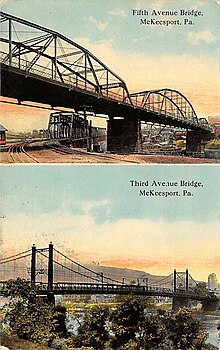Jerome Street Bridge
Jerome Street Bridge | |
|---|---|
 | |
| Coordinates | 40°21′01″N 79°52′13″W / 40.3503°N 79.8704°W |
| Carries | George Lysle Boulevard |
| Crosses | Youghiogheny River |
| Locale | McKeesport, Pennsylvania |
| Other name(s) | Lysle Boulevard Bridge |
| Characteristics | |
| Design | Arch bridge |
| Total length | 762 ft (232 m) |
| Clearance below | 39 ft (12 m) |
| History | |
| Engineering design by | George S. Richardson |
| Opened | May 4, 1938 |
Jerome Street Bridge | |
Location in Pennsylvania | |
| Coordinates | 40°21′01″N 79°52′13″W / 40.350326°N 79.870354°W |
| Built by | Morehouse, T.T.; Fort Pitt Bridge Works |
| Engineer | George S. Richardson |
| MPS | Highway Bridges Owned by the Commonwealth of Pennsylvania, Department of Transportation TR |
| NRHP reference No. | 88000818[1] |
| Significant dates | |
| Added to NRHP | June 22, 1988 |
| Designated PHLF | 2004[2] |
| Location | |
 | |
The Jerome Street Bridge is an arch bridge across the Youghiogheny River connecting the east and west banks of the Pittsburgh industrial suburb of McKeesport, Pennsylvania. The bridge is a rare steel crescent arch bridge.[3] A crescent arch is formed when the intrados and extrados (the ribs) of the arch are not parallel, but instead form two different curves beginning and ending together. The ribs form a truss at the top of the arch and join together in a solid rib at each end.[4] A crescent arch is a two-hinged arch, the ribs are further apart where the bending moment is greatest and close together at each hinge where it is minimized.[5]
History and architectural features
[edit]This bridge was engineered by George S. Richardson.[2][a] A Great Depression-era public works bond was provided to fund the creation of a new auto-centric four-lane highway bridge.
The bridge was dedicated on May 3, 1938 and opened to traffic on May 4. Thousands of people attended the ceremony and parade to celebrate the new bridge. The total cost of the new bridge was $667,000.[6][7]

Originally, the Fifth Avenue Bridge stood on the site. This 1880's truss structure mainly served streetcar traffic and was inadequate for automobiles. It was intended that after the Jerome Street Bridge opened that the older, downstream Third Avenue Bridge (1884) would also be demolished. This suspension bridge structure was also unsafe for continued automobile use. A petition signed by 5,000 people made the Allegheny County commissioners reconsider the plan.[8] The Third Avenue Bridge was kept open for pedestrians only, but was eventually demolished in 1960.[9][10]
After the city renamed Jerome Street which approached the bridge after incumbent Republican Mayor George Lysle, they proposed that the Youghiogheny crossing receive the same eponym. However, the Franklin Roosevelt administration contended that public works dollars could not be used to memorialize living officeholders. As a result, the Jerome Street designation was chosen, and it remains in place today, although it is sometimes referred to as the Lysle Boulevard Bridge.[2]
Rehabilitation projects
[edit]A 2022 project replaced the bridge deck using polyester polymer concrete, repaired the concrete substructure, and replaced the bridge bearings. The work was completed in November 2022.[3]
Notes
[edit]- ^ Condit credits the bridge engineering to Vernon Covell.[5]
References
[edit]- ^ "National Register Information System – (#88000818)". National Register of Historic Places. National Park Service. July 9, 2010.
- ^ a b c Historic Landmark Plaques 1968-2009 (PDF). Pittsburgh, PA: Pittsburgh History & Landmarks Foundation. 2010. Retrieved July 2, 2010.
- ^ a b Szalankiewicz, Shane; Burdette, Nick (May 31, 2023). "Long-term Protection". Roads & Bridges. Nashville, TN: Endeavor Business Media. Retrieved July 3, 2023.
- ^ "Tyne Bridge". HistoricBridges.org. Retrieved July 3, 2023.
- ^ a b Condit, Carl W. (1961). American Building Art: The Twentieth Century. New York: Oxford University Press. p. 339.
- ^ "Bridge Opened at McKeesport". Newspapers.com. Pittsburgh Sun-Telegraph. May 4, 1938. Retrieved July 3, 2023.
- ^ "Thousands See Officials Dedicate McKeesport's New Bridge". Newspapers.com. Pittsburgh Post-Gazette. May 4, 1938. Retrieved July 3, 2023.
- ^ "5,000 Fight Plan to Raze Bridge". Newspapers.com. Pittsburgh Post-Gazette. October 29, 1937. Retrieved July 3, 2023.
- ^ "Bridge is Open for Pedestrians". Newspapers.com. Pittsburgh Post-Gazette. May 27, 1938. Retrieved July 3, 2023.
- ^ Bowers, M.F. (August 6, 2012). "Early History of McKeesport: Part 6". TubeCityOnline.com. Retrieved July 3, 2023.
External links
[edit]- Through arch bridges in the United States
- Road bridges on the National Register of Historic Places in Pennsylvania
- Bridges in Allegheny County, Pennsylvania
- Bridges completed in 1937
- Pittsburgh History & Landmarks Foundation Historic Landmarks
- McKeesport, Pennsylvania
- National Register of Historic Places in Allegheny County, Pennsylvania
- Bridges over the Youghiogheny River
- Metal bridges in the United States
- Tied arch bridges in the United States




